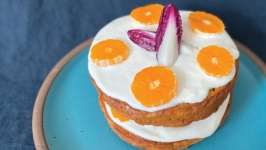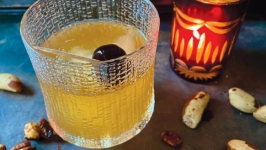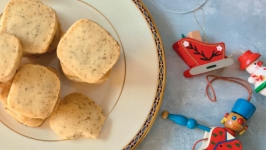Nikipiaq Life
When I want a wholesome meal, I pull out nikipiaq. Real food. My family and I participate in all aspects of subsistence hunting in Point Hope, Alaska. We are a small Inupiaq community with a large selection of food we have the opportunity to hunt and gather. About 80 percent of my family’s diet is from our land and sea. We eat so much nikipiaq that my seven-year-old daughter has her own definition for meat. Angela’s usually the last one at the dinner table every night. On the rare occasion we eat something other than Native food, if I tell her to eat her meat, she says, “This is not meat! It’s chicken!”
Ringed seals are caught in the cold winter months all up until spring. My husband, Jacob III, takes our children out onto the Chukchi Sea ice to hunt seals like our ancestors have done for hundreds of years. Jacob and I have five children and all love to hunt and put meat away. Every year, Jacob takes our three oldest on the ice as much as the weather allows. Kahlia, now 18, Jacob IV, 14, and Fred, ten, are learning how to read the thickness of the ice and weather conditions to be safe while hunting. When the time is right, Angela and Suluk, three, will learn too. Learning how to be safe helps not only with seal hunting, but with our busiest hunting season of all, too—the spring bowhead whale hunt. Every animal harvested is tied into whaling in one way or another. Our subsistence lifestyle revolves around the whale.
Last year, Jacob didn’t even have to catch any seals. Kahlia and Jacob IV harvested enough for the family themselves. It is tradition for hunters to give away their first catch of any animal to ensure they will always be successful. Kahlia and Jacob both caught their first seals several years ago and each gave them to my mom and Jacob’s aunt.
Once the seals are caught, Jacob brings them home and stands them nose-down in the snow. It is not unusual to see two or three seals frozen in our yard until I can skin and put the meat away. It doesn’t take long to skin and harvest the meat, just a few hours. I use an ulu, a homemade rounded-edge women’s knife, to butcher the animal. The seal is dragged into the house and placed on large pieces of cardboard to thaw. It can take from one to three days to fully thaw out. The seal does not smell badly. The smell always reminds me of my grandparents qanitchaq (entryway). It always smelled like seals and maklaks. I absolutely love that smell.
Inupiaq people were always taught to never waste any food because it was needed for survival. Therefore, much of the seal is used and eaten. Even though we have a local store with options, we are still taught to never waste any part of an animal. It is one of our Inupiaq values, to respect the animals.
The blubber can be cut into strips and rendered down to make seal oil, which is a delicious oil used to dip raw frozen fish or raw frozen caribou meat in. It can also be spooned into soups for extra flavor. The skin can be used in different ways, all for sewing clothes or maklaks and more recently, making gorgeous seal skin earrings. A long time ago, our ancestors also skinned the seal without opening it up, so that it was one whole piece. They would start at the mouth and work their way down. The holes were all sewn shut so it would create a buoy that would be used for whaling, and even a storage bag used for food.
The meat can be fried, dried, or made into soup. Ziploc bags are filled and thrown into the freezer for later meals. The heart, kidneys, and intestines are also saved. My family and I all try to hunt and gather as much as possible to fill our freezers not only for our family dinners, but also to cook during our whaling season. My husband is a whaling captain, and I need to feed our crew hearty meals so they can hunt the beautiful bowhead whales in the cold weather.
Once the seal meat is cut up, I slice a long, thin strip of blubber off and set it aside. I then gather as much of the small intestines as I can and clean them. Starting at one end, I pinch my thumb and pointer onto the intestine and squeeze out all the contents into a discard pile. I run my fingers through several times until nothing comes out. Then I start a braid using my pinky and thumb to hold the single piece of intestine and braid it around the thin strip of blubber. It’s almost like my fingers are crochet hooks and the intestine is the yarn. I usually cut the braid in half to serve with two meals. This intricate braid has always impressed me. The braid has been passed down from generation to generation. My ancestors were so knowledgeable in how to survive. I believe God showed them how to endure in these ways. The Arctic has always been a harsh environment, yet my ancestors survived because our sea mammals are so very rich in the necessary vitamins.
There is no beginning and no end to our hunting seasons. It is a continuous year-round cycle. My family and I harvest every animal available in our area: bowhead whales, beluga, walrus, bearded seals, ducks, bird eggs, fish, caribou, polar bear, and ringed seal. Every animal hunted is treated with the same respect because they feed us.
My husband Jacob’s favorite meal is seal soup with braided intestines. I learned to make this effortless meal from my mother-in-law. Seal meat is incredibly soft, but it is also very oily due to the attached blubber. I boil chunks of meat attached with blubber and the braided intestines until they are cooked through. Then I add rice, macaroni noodles, and finally salt. This is a remarkably simple, yet satisfying meal. The whole braid is taken out and cut up and added back to the soup. The intestines are the star and add the bulk of the flavor. It is a delicacy. They are slightly chewy and firm in texture.
Seal soup has always been my husband’s favorite food. His mom always tells this story about Jacob III and his older brother with a laugh. “I cooked seal soup just before a high school basketball game. We ran out of time, so we had to take off to attend our son’s game, and we decided to eat after,” said Della Lane. “When we got home, we noticed someone had had some soup. We started pouring soup into our bowls with some meat. We dug around the pot with the ladle to look for the intestines. I kept looking, thinking it’s at the bottom somewhere. I realized there wasn’t any intestines. With confusion I asked Jacob Jr., ‘Where’s the intestines?’ He said he didn’t know. We ate our soup without intestines, and waited for the boys to come home and asked them. They admitted they ate all the foot-and-a-half-long intestines by themselves. They didn’t save any for us. That’s how much they enjoy eating them.”
I believe nikipiaq can be used as a medicine. God knew what He was doing when He created these animals for our consumption. My mom used to give me and my siblings a spoonful of seal oil a day to keep healthy. Beluga oil is used on children who have a bad cough, just as one would use Vicks VapoRub. When my family is sick with a cold, I always make hot soup, especially caribou soup with bones, so the bone marrow can render a bit and it helps to make us feel better. Plants in our area are also used to make tea to ward off sickness.
Seals are just one strand in our subsistence lifestyle. There is no beginning and no end to our hunting seasons. It is a continuous year-round cycle. My family and I harvest every animal available in our area: bowhead whales, beluga, walrus, bearded seals, ducks, bird eggs, fish, caribou, polar bear, and ringed seal. Every animal hunted is treated with the same respect because they feed us. Jacob and I will continue to teach our children and, hopefully, future grandchildren in the same way we were taught—with great respect and thankfulness to God.















